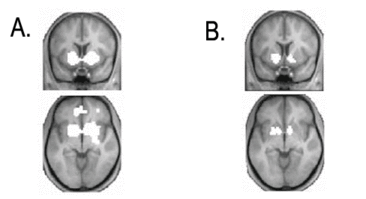Researchers and clinicians have debated where pathological gambling fits among substance use and impulse control disorders. Although pathological gambling falls under the impulse disorder category, it shares many similarities with the conditions of substance abuse and dependence according to DSM-IV-TR (American Psychiatric Association, 2000). Neurological evidence suggests that individuals diagnosed with certain substance use disorders show deficiencies in both reward activation and impulse control pathways of the brain’s reward system. (For reward system articles: WAGER 8(31), WAGER 8(33)). This week’s WAGER reviews a new study that suggests pathological gambling might share some characteristics of both substance use disorders and impulse control disorders (Reuter et al., 2005). The research team recruited 12 pathological gamblers and 12 normal controls. The gambling subjects had a diagnosis of pathological gambling according to both the DSM-IV and a German instrument (KFG) (Petry, 1996) similar to the South Oaks Gambling Screen (SOGS). Neither the experimental subjects nor the controls had a DSM-IV diagnosis of substance abuse or dependence.
Researchers presented subjects with a novel gambling task: subjects guessed which of two cards (one red-faced, one green-faced) presented face-down was red. Subjects had 15 euros (approximately $20) as a beginning balance. They gained one euro for each correct guess and lost one euro for each wrong guess. The experimenter manipulated the task in order to leave all subjects with eight euros by the end of the session. Subjects completed three sessions with 79 guessing trials in each session. Technicians took functional magnetic resonance imaging (fMRI) scans in 38 very thin axial slices permitting researchers to focus on the ventral striatum and the ventromedial prefrontal cortex. The ventral striatum is implicated in reward and motivation behavior (Schultz, Apicella, Scarnati, & Ljungberg, 1992), whereas the ventromedial prefrontal cortex (VMPFC) is implicated in emotional responses related to reward (Shamay- Tsoory, Tomer, Berger, & Aharon-Peretz, 2003); both areas are part of the reward system circuitry. A decreased activation of the ventral striatum is clearly associated with substance use disorders (Volkow, Fowler, Wang, & Goldstein, 2002) and a decreased activation of the VMPFC is related to reduced impulse control, sometimes in the presence of a substance use disorder and sometimes not (Rogers et al., 1999) .
In this study, gamblers exhibited decreased activation in two brain areas both related to reward response. Figure 1 shows decreased activation in the ventral striatum for pathological gamblers compared to controls. Specifically, pathological gamblers, compared with controls, showed significantly lower activation in the right ventral striatum (peak x.y.z: 33, 12, -6 mm; t = 4.9, df = 18, p <.05, corrected for multiple comparisons), and significantly lower activation in the VMPFC (peak, x, y, z: -3, 54, -12 mm; t = 4.7, df = 18, p< .05, corrected for multiple comparisons). The authors also found a significant negative correlation between severity of pathological gambling and response in both the right ventral striatum (r = -0.77; t= 3.8, df = 10, p<0.05), and response in the VMPFC (r = -0.53; t = 2.0, df = 10, p<0.05).
Figure 1. a. activation in the ventral striatum in controls b. Decreased activation in the Ventral Striatum in pathological gamblers (adapted from Reuter et al., 2005).
Used with permission from Nature Publishing Group.
One limitation of the study is that the task only offered the subjects one choice and one interaction: to turn over one card. Because most gambling involves increased interaction and a greater variety of choices and skill (e.g., process of placing bets or folding, repeated options to continue or leave the game, quarter slots or one dollar slots), this particular task might not adequately represent in vivo or real life gambling. Perhaps a more complex set of pathways are activated during another gambling session that is more realistic. These results suggest that pathological gamblers experience diminished reward from gambling. This might mean that pathological gamblers need to gamble excessively just to achieve the levels of excitement that control subjects experience with a lower level of gambling. This study is unique because it provides information about pathological gamblers compared with controls; this research suggests that pathological gambling might indeed have characteristics common to impulse control problems and intemperate substance use.
Comments on this article can be addressed to Michael Stanton.
References
American Psychiatric Association. (2000). DSM IV-TR: Diagnostic and statistical manual of mental disorders–Text revision (Fourth ed.). Washington, D.C.: American Psychiatric Association.
Petry, J. (1996). Psychotherapie der Glücksspielsucht. Weinheim: Beltz/Psychologie Verlags Union.
Reuter, J., Raedler, T., Rose, M., Hand, I., Glascher, J., & Buchel, C. (2005). Pathological gambling is linked to reduced activation of the mesolimbic reward system. Nature Neuroscience, Advance online publication.
Rogers, R. D., Everitt, B. J., Baldacchino, A., Blackshaw, A. J., Swainson, R., Wynnea, K., et al. (1999). Dissociable Deficits in the Decision-Making Cognition of Chronic Amphetamine Abusers, Opiate Abusers, Patients with Focal Damage to Prefrontal Cortex, and Tryptophan-Depleted Normal Volunteers: Evidence for Monoaminergic Mechanisms. Neuropsychopharmacology, 20(4), 322.
Schultz, W., Apicella, P., Scarnati, E., & Ljungberg, T. (1992). Neuronal activity in monkey ventral striatum related to the expectation of reward. Journal of Neuroscience, 12(12), 4595-4610.
Shamay-Tsoory, S. G., Tomer, R., Berger, B. D., & Aharon-Peretz, J. (2003). Characterization of empathy deficits following prefrontal brain damage: the role of the right ventromedial prefrontal cortex. Journal of Cognitive Neuroscience, 15(3), 324-337.
Volkow, N. D., Fowler, J. S., Wang, G. J., & Goldstein, R. Z. (2002). Role of dopamine, the frontal cortex and memory circuits in drug addiction: insight from imaging studies. Neurobiology of Learning and Memory, 78(3), 610- 624.





